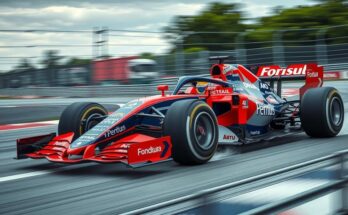U.S. tariffs of 25% on all auto imports have raised concerns for India’s $7 billion auto component exports. The impact is particularly felt by Jaguar Land Rover, which relies on the U.S. market. While components exports may face pressure on margins, analysts believe the overall effect on the Indian auto industry could be manageable due to diversifications and strategic adjustments.
The recent decision by U.S. President Donald Trump to impose a 25 percent tariff on all auto imports, effective April 2, has introduced uncertainty regarding India’s approximately $7 billion in auto component exports to the United States. While the direct export of complete vehicles from India to the U.S. remains minimal, Tata Motors’ luxury brand, Jaguar Land Rover (JLR), is significantly affected, with around 23 percent of its units sold in the U.S. during FY24. JLR’s pricing and profitability may suffer as they might need to pass on the higher costs to consumers, which could reduce their competitive edge in the market.
Indian auto component manufacturers face significant exposure to these tariffs, with Sona BLW relying on 43 percent of its revenues from U.S. exports, and Bharat Forge obtaining 38 percent from the same market. Trading figures show that India’s auto component exports to the U.S. reached $6.79 billion in FY24, while imports stood at $1.4 billion prior to the announced tariff, which raised duties significantly from a near-zero rate to 15 percent. Industry experts emphasize that the auto components sector will bear the brunt of this tariff burden more than vehicle manufacturers, who do not export entire cars to the U.S.
According to Anuj Sethi from Crisil Ratings, the proposed tariffs on significant components—including engines and transmissions—could reduce the operating margins for Indian auto component manufacturers by 125-150 basis points from the current margins. Approximately one-fifth of India’s auto component sector’s revenue arises from exports, with 27 percent directed toward the U.S. market. Consequently, profitability for indirect suppliers to Tier I manufacturers could also be compromised, although manufacturers with U.S. facilities might offset declines through improved capacity utilization.
Analysts highlight that while the tariffs will impose challenges, certain components of India’s automotive exports to the U.S. risk facing less severe impacts than initially perceived. Mrunmayee Jogalekar of Asit C Mehta Investment noted that although Tata Motors will encounter difficulties due to JLR’s reliance on U.S. sales, other manufacturers maintain diverse export markets that may cushion overall effects. Some experts have postulated that the tariffs on auto parts, specifically, might create avenues rather than barriers for domestic exporters, suggesting an analysis by the Global Trade Research Initiative that indicates minimal impact.
An examination of India’s automotive exports underscores that the actual volume of cars exported to the U.S. remains limited, with figures indicating its insignificance (e.g., only $8.9 million in passenger car exports). With the U.S. generally importing vast quantities of auto parts globally, India’s contribution is comparatively small, leading analysts to believe that the auto component sector might adapt well to these challenges. Ravi G Bhatia from JATO Dynamics expressed skepticism over the toll of the tariffs, stating that they should not be perceived as catastrophic but rather manageable.
The Automotive Component Manufacturers Association of India (ACMA) and the Society of Indian Automobile Manufacturers (SIAM) have refrained from commenting on these developments publicly. Discussions among leading manufacturers suggest that several have initiated plants in neighboring countries to utilize trade agreements, which may cushion the shock of U.S. tariffs. Motherson Group’s strategy involves establishing facilities close to customers to mitigate the impact of such tariffs, reiterating that any resultant cost increases may ultimately be borne by consumers.
In summary, while the imposition of a 25 percent tariff on auto imports by the U.S. presents significant challenges to India’s automotive components sector, particularly regarding exports totaling $6.79 billion in FY24, the impact on the complete vehicle exports remains limited. Analysts suggest that although profit margins for specific manufacturers like JLR may be affected, the overall resilience and diversified strategies of India’s auto component industry could lead to adaptability in these evolving circumstances. Furthermore, the nuanced analysis of the supply chain indicates that select companies may still find opportunities in U.S. manufacturing to counterbalance the observed risks from tariffs. Overall, the future of Indian automotive exports may hinge on strategic responses rather than mere tariff adjustments.
Original Source: www.hindustantimes.com




